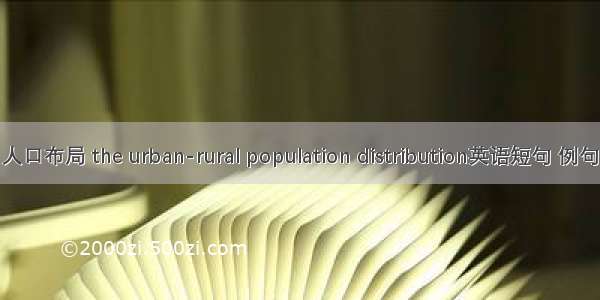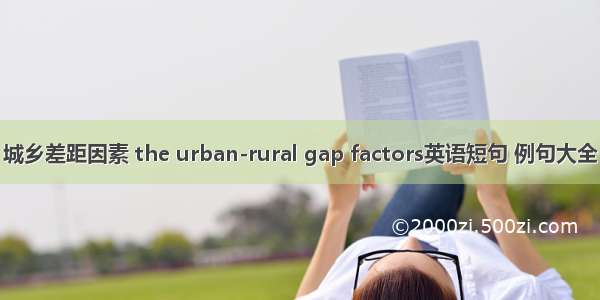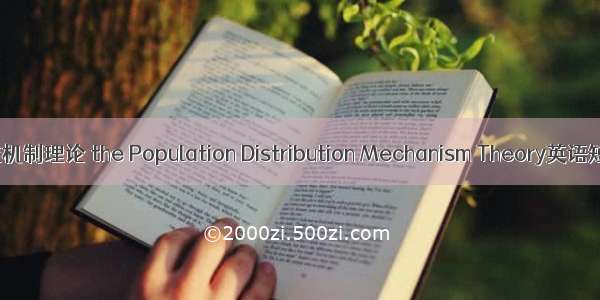
城乡人口布局,the urban-rural population distribution
1)the urban-rural population distribution城乡人口布局
1.This paper studies the development history, status quo and pattern, and the mechanism ofthe urban-rural population distribution in Shandong province, by the method of documentary and comparative analysis.研究结果是:(1)山东省城乡人口布局的发展水平差距比较大。
2)urban and rural population distribution城乡人口分布
3)urban-rural population城乡人口
英文短句/例句
1.The deal with of rural-urban migration in the multi-regional population project model and its projection in China;分城乡人口预测中乡-城人口转移技术处理及人口转移预测
2.Study on the Large-scale Effect of the Migration and Cluster of Urban and Rural Population;城乡人口迁移与集聚的规模效应研究
3.Multifractal Characterization of the Distribution Pattern of the Urban and Rural Population;城乡人口地域分异特征的多分形刻画
4.The Population s change and the means of make a living between city and countryside in modern China;近代中国城乡人口的变化与谋生手段
5.Systematic Analysis on the Labor Shifting From Rural Area Cities in the Northern Slope Area of Tianshan Mountain天山北坡区域城乡人口迁移系统分析
6.The Construction and Application of Coordinating Urban And Rural Population Projection Model: A Case of Shaanxi province统筹城乡的人口预测模型构建与应用——以陕西省城乡人口分年龄预测为例
7.Of the total population, those living in urban areas were 379.42 million, accounting for 30.4 percent and those living in rural areas were 868.68 million, accounting for 69.6 percent.其中,城镇人口37942万人,占30.4%;乡村人口86868万人,占69.6%。
8.The Differential Effects of Population Urbanizationon the Human Resources Developmentin the Urban and the Rural Areas;人口城市化的差别效应和城乡人力资源开发
9.The Research of China s Population Migration Theory and Model from Rural to Urban Areas;我国人口城乡迁移的理论与模式研究
10.Research on a Comparison of Caring Mode between Urban Areas and Countryside for the Aged in China;我国城乡老年人口养老方式比较研究
11.A Comparative Study on the Quality of Life of Urban and Rural Elderly Population in China;我国城乡老年人口生活质量比较研究
12.Study on Childbearing Willing of the Rural-to-Urban Migrants of New Generation新一代乡-城流动人口生育意愿探析
13.Research of population urbanization development under the idea of city and village planning;城乡与区域统筹思想下的人口城市化发展研究
14.An Analysis of the Influence of the City Population Growth Standardon the Employment Rate in the City and the Countryside;我国人口城市化水平对城乡就业率影响分析
15.A STUDY ON THE QUESTION BETWEEN POPULATION URBANIZATION AND EMPLOYMENT OF CITY AND RURAL IN CHINA;中国人口城市化水平与城乡就业问题探讨
16.Analysis of Rural urban Migration and Urban Unemployment Problem in Our Country;我国乡-城人口流动与缓解城镇失业问题分析
17.The Study on the Urban-rural Population Distribution of Shan Dong Province under the Urban-rural Harmonious Development基于城乡协调发展视角的山东省城市与乡村人口布局研究
18.Rural-Urban Migration and Sex Ratio at Birth in Urban regions of China:Analysis based on 5~(th) Census;中国乡城人口流动与城镇出生人口性别比——基于“五普”数据的分析
相关短句/例句
urban and rural population distribution城乡人口分布
3)urban-rural population城乡人口
4)population distribution人口布局
1.This paper puts forward strategy and planning guide ofpopulation distribution in Shanghai based on the fifth national census and relative experience of the large cities inside and outside China.本研究根据上海市城市总体规划所确定的城市人口发展目标 ,在深入分析了第五次人口普查资料的基础上 ,借鉴了国内外特大城市人口分布的发展变化特征及其经验 ,研究上海人口分布变化与布局的规律与特点 ,提出了上海人口布局战略目标和规划导向 ,以及实施上海市人口布局战略目标的若干对策 :实施旧区与郊区联动发展 ;控制中心城继续蔓延式发展 ;引导城市轴向组团式发展 ;增强郊区城镇综合实力 ;吸引中心城及农村人口落户城
2.The society, economic and even culture are affected by thepopulation distribution and structure of the area.再次,在对长三角地区的人口和产业布局分析的基础上,结合世界城市群发展对本地区的启示,提出长三角地区人口发展中面临的问题以及促进本地区人口布局和产业布局优化的对策建议。
3.Momentous constructions make profound influence onpopulation distribution,so positive effects are emerging for the policy of lower density in inner city that has long been advo-cated by urban government.城市功能布局由此进入大调整时期,一系列的重大建设项目由此展开并对城市人口布局产生深刻影响。
5)migration of urban and rural population城乡人口迁移
6)urban and rural poverty-stricken population城乡贫困人口
延伸阅读
人口分布特定时点人口在地理空间位置上的分布状态。它是通过自然变动和迁移变动不断调整的人口再分布过程的瞬时表现,也是人口动态变化的静态映象。人口有水平分布和垂直分布之分。前者是人口按陆地平面投影的地理位置分布的状况;后者则是人口按海拔高度所在的分布状况。世界人口的水平分布很不均匀,按纬度地带来说,主要分布在20°~60°的范围之内,低纬度地带,除局部地区外,人口偏少,高纬度地带更为稀少。按地区来说,亚洲东南半壁、欧洲以及北美洲东部是3个最大的人口稠密区,其人口数占世界人口总数的70%左右。其余地区,除规模较小的密集区外,大都为人口稀疏区。按距海远近来说,全世界有过半数的人口居住在离海岸线200公里以内的地带,大陆腹地多为人烟稀少区域。垂直变化的总特点是人口随高度的增大而减少。影响人口分布的因素有自然环境、经济条件和历史条件。自然环境对人口分布的影响,主要通过纬度、地势地形和气候反映出来。纬度过高或过低对人类生活都不相宜,高纬度地带的限制尤为严酷。寒冷、土壤冻结、光照不足使土地得不到开发,迄今人类定居的北界大致与一月平均气温 -20℃的等温线相合。地势高、起伏大也妨碍人类居住。中纬度地带居民多定居在地势较低的地方,只有部分热带国家利用气温垂直递减的规律,选择一二千米以上的高原或山间定居。干燥气候和湿热气候都有碍于人口分布,随着科技与医学的进步,湿热环境的不利影响正在克服,但干旱的环境仍然是人口活动的重大障碍。自然环境提供了人口分布的地理框架,而人口分布的格局则决定于社会经济条件。在前资本主义社会,农业是压倒一切的生产部门,人口分布表现为土地依存型或农牧业依存型,相对分散而均衡,政治中心和文化中心常常集中大量人口。商品经济的发展影响人口向城镇集中,但在以农业生产为主的社会中,城市人口不占重要地位。人口密度的差异取决于土地肥力、土地利用方式(农或牧)、作物种类、灌溉条件、集约的程度等因素共同作用下的单位面积产量或载畜量。在资本主义社会和社会主义社会,工业、交通、商业、国际贸易的发展,使人口分布转向工业依存型。在这一转变中,工业是动力,交通运输业是杠杆。工业在城镇的集聚,相应地吸收着基本人口和服务人口,使乡村人口源源转入城镇,城镇体系逐渐形成,人口分布格局从散布型走向点、轴集中型。国际贸易的发展,更刺激了沿海港口城市的成长,促进了海岸带人口的密集。这一过程在资本主义制度下是自发的,在社会主义制度下能够通过有计划的合理布局生产力,为合理调节人口分布创造条件。历史条件也是影响人口分布的一个因素。历史上人口长期增殖的结果,往往造成在开发较早、历史悠久的地区,人口一般较多,例如旧大陆的人口密度比新大陆要高。人口分布的状况,往往与历史上的人口大迁移有关,由于迁移的背景不同,有时会产生奇特的分布现象。例如,阿尔及利亚境内冬冷夏干的崎岖山地,人口密度反而比全国平均数大几倍的反常现象,就是历史上异族入侵,迫使当地居民进山避难所造成的。人口分布还按各大洲、各国以及各级行政区域划分。亚洲人口占世界人口的50%以上。世界上有 7个国家的人口在1亿以上,其中中国人口到1990年7月1日达11.6亿,占亚洲人口的1/3多,约占世界人口的22%。
















